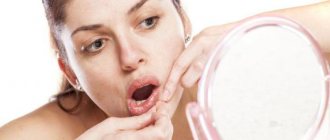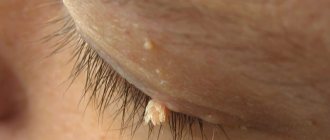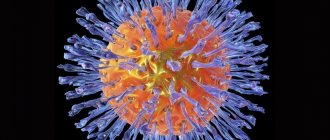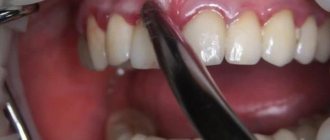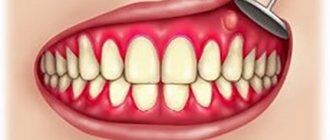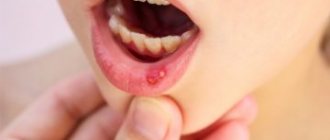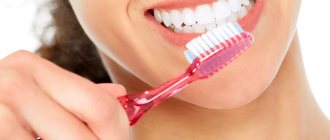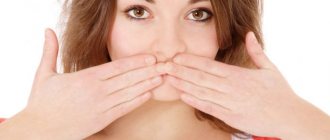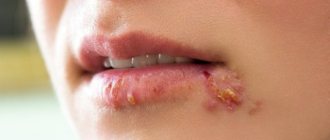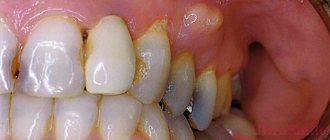In women 20-45 years old who are prone to allergic reactions, the area around the mouth sometimes becomes inflamed - the chin and perioral skin - the process indicates a pathology such as perioral dermatitis, the photos in the article clearly demonstrate what the disease looks like.
Reference! The disease is also called steroid facial dermatitis, perioral dermatitis, perioral rosacea. Moreover, it is believed that flight attendants most often suffer from the disease, because flight attendants have to use a lot of lipstick, mascara, powder, and makeup in order to always be on top in the literal and figurative sense of the word.
Perioral dermatitis - what is it, photo
According to the International Classification of Diseases (ICD-10), dermatitis is assigned code L 71. 0. According to statistics, 1% of the population suffers from the pathological condition, among whom women of reproductive age predominate, and rarely children and males. Pay attention to how perioral pathology looks in the photo in children.
Perioral dermatitis photos in children
Perioral dermatitis is an inflammatory skin lesion with rashes and redness of the epidermal layer. The rash is localized near the nose, mouth, chin, and sometimes occurs around the eyes.
Symmetrical rashes are usually observed, but there are cases of unilateral concentration. The photos show the severity of the process.
Perioral dermatitis on the face photo
At an early stage, the disease manifests itself as small red papules - nodular formations, small pinpoint pimples, easily distinguishable in the photo.
The process begins with skin irritation, but over 7-30 days the nodules progress and affect a large surface area of the face, sometimes merging together and creating psychological and physical discomfort for the patient. The skin of a patient with dermatitis peels off and pustules appear.
Photo of perioral dermatitis
The symptoms of perioral dermatitis are similar to those of Broca's pigmented perioral dermatosis, which is characterized by the appearance of yellowish-brown spots around the mouth, chin and nasolabial folds.
Erythrosis pigmentosa of the face (Broca's dermatosis) also occurs predominantly in young women and is caused by dysfunction of the gastrointestinal tract.
Attention! A distinctive feature of perioral dermatitis is clear contours separating healthy skin from affected skin. Therefore, at the first symptoms of perioral pathology, an urgent consultation with a dermatologist is necessary to avoid complications and the transition of dermatitis to the chronic stage.
Cheilitis as a cause
Irritation around the mouth in adults and children can occur as one of the symptoms of cheilitis. Additionally, this disease is accompanied by the appearance of sticking in the corners of the mouth. The causes of this disease lie in the activation of pathogenic microorganisms or fungi. They can remain in the body for a long time without showing anything. But when favorable conditions appear, they begin to become more active. Provoking factors for the development of cheilitis include:
- presence of diabetes mellitus;
- acute deficiency of B vitamins in the body;
- the presence of an incorrect bite, in which irritation and injury to the teeth constantly occurs around the lips. Most often, the upper teeth injure the skin.
After prolonged antibiotic therapy, cheilitis of fungal etiology may develop. At the same time, jams appear in the corners of the mouth, covered with a whitish coating. The top of the sores are covered with crusts. With bacterial cheilitis, small blisters appear in the corners of the mouth, which open when moving the mouth. Additionally, irritation, peeling, and excessive dryness of the epithelium appear on the surface of the skin. Often this disease develops in children because they often bite their nails and put dirty objects and toys in their mouths.
Types of Perioral Dermatitis
Dermatitis is a complex of symptoms that appear in response to a specific irritant. There are two types of perioral rosacea (examples with photos):
- Contact form - appears due to skin contact with a harmful substance, perceived by the body as an antigen;
- Toxicoderma (toxicoallergic dermatitis) - caused by internal exposure to allergens.
Perioral dermatitis under the nose and on the chin photo
Depending on the cause, skin dermatitis is divided into four types (photo):
- Seborrheic dermatitis - occurs due to functional disorders of the sebaceous glands, when a large amount of sebum is produced. Signs of the disease - acne and pimples, if the scalp is affected - dandruff;
- Contact dermatitis is caused by external factors. The disease is manifested by redness of the skin, allergic rashes at the site of contact with the allergen;
- Allergic skin dermatitis - caused by the influence of internal factors, does not appear immediately, but a week or two after contact with the irritant;
- Atopic dermatitis is a hereditary pathology.
Article on the topic: Sun allergy - types, symptoms and treatment
Perioral dermatitis - photos, symptoms and treatment
It is important! Treatment of dermatitis depends on the type and stage of skin damage. Skin reactions are caused by food, medications, interactions with animals and plants, toxic detergents, burns and other allergens.
Regardless of the form of the pathology, dermatitis always has three stages of development - acute, subacute and chronic.
Nutrition for redness around the mouth in children
If redness is the result of external influences (reaction to sunlight, cold air) or infection, then it is recommended to temporarily exclude from the diet:
- spices;
- spicy and salty foods;
- fruits whose juice increases skin irritation (pineapple, kiwi, citrus fruits);
- tomatoes.
If inflammation is caused by a malfunction of the digestive and gastrointestinal tract, then a diet is necessary that excludes foods that cause allergic reactions, and consumption of oat and rice porridges, vegetable soups, and low-fat broths is also recommended. The child has developed redness of the skin around the mouth - this is not a reason to panic, but such manifestations should not be left to chance.
Timely identification of the causes and measures taken will help the child recover faster and get rid of discomfort.
Article design: E. Chaikina
Causes of steroid facial dermatitis
The causes of steroid dermatitis of the face are both allergic and atopic in nature, so modern medicine has not yet been able to accurately identify what causes perioral disease. However, factors contributing to the development of the disease have been identified:
- the influence of hormonal drugs - creams, oral contraception;
- toothpaste containing fluoride;
- anti-asthma aerosols (in the presence of bronchial asthma);
- exposure to ultraviolet rays;
- sudden change in climatic conditions;
- disruption of the endocrine system, hormonal disorders;
- chronic infections and inflammations in the body;
- procedures that injure the skin using scrubs;
- decreased protective functions of the immune system;
- frequent stressful situations;
- increased sensitivity of facial skin;
- hypersensitivity to bacterial allergens;
- dysfunction of the digestive and nervous systems.
Perioral dermatitis in a child under the nose photo
Studies have found that perioral dermatitis often appears in women who actively begin to care for their facial skin and use more than three “multi-directional” cosmetics at the same time (for example, moisturizing, nourishing, decorative).
Photos of the area affected by dermatitis are presented in the article. Before using cosmetics, it is important to study the composition and avoid products containing the following components:
- petrolatum;
- paraffin;
- cinnamon flavorings;
- nutria salt of lauryl sulfuric acid;
- myristic acid isopropyl ester.
Photo of perioral dermatitis around the mouth and under the eyes
The above components disrupt connective tissue fibers, affect blood vessels, which provokes inflammation on the facial skin in the form of perioral rosacea - let’s pay attention to the photo of dermatitis due to inappropriate cosmetics.
Note! Dr. Komarovsky and fellow doctors note that in children, perioral dermatitis is often associated with the problem of dental caries. Perioral rosacea also occurs in infants who suck on a pacifier in cold or windy weather. Children suffering from bronchial asthma and chronic rhinitis are susceptible to perioral dermatitis, because the use of hormonal aerosols provokes the occurrence of perioral pathology. After stopping the medications, the skin around the mouth heals.
Folk remedies that help relieve irritation around the mouth: recipes, rules of use
If a child has redness of the skin around the mouth, traditional medicine recipes can be used as an addition to therapy:
| Name | Properties | Cooking method |
| Celandine Calendula St. John's wort | in the fight against pustular lesions | A strong decoction (2 tablespoons of any herb is infused for 2 hours in 200 ml of boiling water). The liquid is used for lotions 2-3 times a day. |
| Celandine Chereda | anti-inflammatory | Decoctions (1 tablespoon of one of the herbs is simmered over fire in 120 ml of water). Used as short-term applications 3 times a day or as an additive to bathing water. |
| Periwinkle | against itching | 1 tbsp. l. raw materials are brewed with 1 glass of water and simmered for 10-15 minutes. on fire. The liquid is added to the bathing water. |
| Tar soap | restorative | In its pure form it is used as applications or compresses. Not recommended for weeping eczema. |
| Tea tree oil | antifungal, antimicrobial, antiviral | Apply 2-3 drops to the affected area and rub in lightly. |
To successfully use folk remedies, you must adhere to the following rules:
- local manipulations are performed only on clean skin;
- when using folk recipes, it is necessary to take into account the individual reaction of the body;
- to determine the skin's reaction to the product, it is recommended to test it on an area with healthy skin on the bend of the elbow or wrist;
- if symptoms worsen, the drug must be discontinued;
- the resulting funds are stored in glass jars with well-closing lids;
- Decoctions and infusions cannot be stored for long periods of time and may lose their properties when exposed to light.
The first signs of perioral rosacea
The first signs of steroid dermatitis of the face are characterized by redness of the skin, which is more pronounced when eating spicy and hot foods, which is noticeable in the photo.
Some time later, the epidermis acquires a brighter shade and becomes covered with small pustules, similar to acne, which subsequently turn into crusts and peel off - see the photo of the inflammatory process.
Article on the topic: Akriderm instructions for use. What does the ointment help with and patient reviews?
Perioral dermatitis photo
During the course of the disease, the color of perioral rashes changes from red-brown to light brown - changes are visible in the photo. The localization of the rash on the chin, nasolabial folds, nearby corners of the lips, cheeks is symmetrical, sometimes the pimples merge together. Single rashes may form on the temples and bridge of the nose.
Fact! Some people are diagnosed with diffuse inflammation of the entire face with a white stripe between the border of the lips and the area of inflammation. The photos convey the full severity of the process - with pain and burning in the mouth and chin, the formation of small pimples, the heads of which open up and the separation of transparent and subsequently purulent exudate is observed.
Symptoms of perioral dermatitis
Perioral rosacea always manifests itself as pronounced rashes on the face, which is difficult not to notice in the photo. The symptoms of dermatitis are similar to those of other skin diseases.
Perioral dermatitis: causes, symptoms, photos
Perioral dermatitis has the following clinical manifestations, which are difficult not to notice in the photo:
- severe redness around the mouth with pronounced contours of the affected area;
- the formation of red bumps, similar to pimples, in the area of the lips, chin, nasolabial folds, less often - around the eyes, on the eyelids. The size of the bubbles does not exceed 2-3 mm;
- swelling of the skin;
- feeling of tightness, dryness, itching, pain;
- the formation of fluid in pimples, which over time turns into pus;
- the appearance of scales, which subsequently peel off.
The severity of symptoms depends on the duration of dermatitis and periods of exacerbation or remission. The photo shows the symptoms of perioral rosacea, taking into account the stage of the disease.
Often, people suffering from perioral dermatitis self-medicate, as a result of which, after using inappropriate medications, additional symptoms that aggravate the situation arise - see the photo for clarity:
- thickening, roughening of the skin;
- lumpiness and unevenness of the skin;
- disorder of skin pigmentation with painful sensations.
Note! A characteristic feature of perioral disease is a narrow, two-millimeter strip of skin between the lips and the inflamed area.
Why does the skin around the mouth dry out?
The skin of the lips and around them is very sensitive and does not have sebaceous glands, so it must receive moisture and nutrition from the outside. If you do not use balms or moisturizing lipstick, especially in the cold season, the skin of the lips and around it begins to peel off. The main reasons for this phenomenon include:
What can cause a patchy red rash to appear on someone's lips? This happened to me for several weeks. Is it acne or some kind of cold pain or something else at all? The rash doesn't hurt or itch, but I don't like the way it looks.
Why does the skin around the mouth peel and dry?
There are many different things that can cause lip rashes.
It depends on where the rash is - is it on the lip itself, or is it just above the lips or around the lips? It is also important to know what size the patchy aspects of the rash are, is it exact or larger? For these reasons, it is important to be examined by a dermatologist who can better examine the lips. If the rash consists of pinpoint red dots on the lips that are asymptomatic, this may be secondary to what are known as petechiae, which are small vessels that have burst
To avoid flaking around your lips, try not to lick or bite them (this is a bad habit, especially in children), apply a special balm against flaking and cracking, or use a moisturizing lipstick that does not dry out your lips. In addition, regularly apply your care cream to the skin of the lips and around the mouth, after a good cleansing of the face. Use soft scrubs and peels on the skin of your lips, this will help remove dead skin particles. If you go outside in the cold, be sure to apply a nourishing protective cream or balm.
This may be due to lip sucking or when the platelet count is low. Tiny yellow dots on the lips are called Fordyce glands and are not dangerous. Lip rashes can be caused by infectious causes such as viruses such as herpes, which tend to look more like small blisters that can often be painful, or warts or bacteria. A rash can also form if you use a product to which you are allergic, this is called a "contact allergy" and can be associated with lipstick, lipstick or lipstick.
Diagnostics
At the first signs of perioral dermatitis, you should consult a dermatologist. The specialist will carefully examine the affected areas of the perioral area, then prescribe additional tests to accurately make a diagnosis.
Types and types of dermatitis
To exclude steroid dermatitis of the face, bacterial culture is prescribed. A scraping is taken from the affected skin and sent for laboratory tests. Bacterial culture shows the presence of fungi and infections that provoked the inflammatory process.
Reference! In case of perioral disease, fungi of the genus Candida are often detected, causing thrush (candidiasis) of the oral cavity.
Additionally, the dermatologist advises to undergo an analysis to determine allergens that affect the development of perioral rosacea.
Based on ready-made tests, the doctor will make the correct diagnosis and select treatment taking into account the individual characteristics of the patient’s body and the characteristic manifestations of dermatitis.
Note! To exclude perioral disease, it is not recommended to conduct histology of the skin, since histological examination does not reveal changes specific to dermatitis.
Article on the topic: Effective methods of combating drug allergies
How is therapy carried out?
Treatment of cheilitis should be carried out only under medical supervision. It is not recommended to self-medicate, relying only on the external manifestations of the disease, since if the cause of the disease is not eliminated, it may recur again. Considering the type of pathology, the dentist will tell you how to treat the disease correctly and what further preventive measures should be taken.
In addition to the dentist, treatment is carried out by an allergist or dermatovenerologist. Therapeutic measures are carried out depending on the type of disease.
If ecfoliative cheilitis is diagnosed, the key should be the impact on the psychological background. You will need to visit a neurologist, psychotherapist, and then sedatives, sedatives, or even tranquilizers will be prescribed. When treating the granular form, it is advisable to use anti-inflammatory medications, including Tetracycline, Erythromycin ointment, Flucinar, Sinalar. All these remedies have a good healing effect.
When fighting the candidiasis form of the disease, antifungal agents are used - ointments or gels (Clotrimazole, Lamikon), antiseptics (chlorhexidine, miramistin). Additional measures are taken to strengthen the immune system. To get rid of atopic disease, you must first eliminate potential irritants and allergens from your life. Antihistamine ointments that have antipruritic, anti-inflammatory, and antiallergic effects are used locally. If prescribed by a doctor, you can use products such as Flucinar and Prednisolone ointment.
To get rid of the meteorological type of disease, it is necessary to eliminate the negative influence of climatic conditions from life. Locally apply products containing hormonal substances - Hydrocortisone, Prednisolone ointment. It is imperative to use protective equipment against ultraviolet radiation. Vitamin substances are prescribed for internal use.
Additionally, immunomodulators, antivirals, antihistamines and hormonal drugs may be prescribed. If therapy is timely, the prognosis is favorable. If there is no therapy, the consequences can be dangerous, so do not delay visiting the dentist.
Treatment of perioral dermatitis
The treatment regimen for perioral pathology is complex, it all depends on the severity of the disease. Sometimes it takes more than 3 months to fully recover.
For a complete cure, doctors recommend an integrated approach using various medications and dietary nutrition.
Look at the photos showing the abundance of medications for the treatment of dermatitis. If all medical instructions are followed, the likelihood of complete remission is high.
Antihistamines for perioral dermatitis
Ointments, creams, antibacterial therapy
Treatment of perioral disease begins with the abolition of all hormonal drugs used by the patient.
Therapy for perioral dermatitis is based on the following drugs:
- local treatment with creams, ointments, gels with antibiotics - Metronidazole (Metrogyl) 1%, Erythromycin 2%. If Metronidazole is intolerant, Skinoren, Bepanten, and zinc ointment are prescribed;
- antihistamines - Zyrtec, Suprastin, Tavegil;
- antibacterial therapy - Doxycillin, Tetracycline, Unidox Solutab, Azithromycin;
- in case of severe stress, the use of sedative medications is recommended - Fitosed, Menovalen, Sedafiton;
- vitamin and mineral complex;
- absorbent medications - Polysorb, Enterosgel.
How to treat perioral dermatitis
At the final stage of treatment of dermatitis, physiotherapy is effective - cryomassage using liquid nitrogen or snow. The photo shows the changes occurring in the patient after treatment of perioral disease.
Diet for dermatitis
Patients with perioral dermatitis are prescribed a special hypoallergenic diet. If dietary measures are unsuccessful, the diet can be replaced with short-term therapeutic fasting according to an individual scheme.
Let's pay attention to the table of allowed and prohibited products for perioral rosacea:
| Authorized Products | Prohibited Products |
| wholemeal bread | eggs, mushrooms |
| fermented milk products | fish, caviar, fish and sausage products |
| cereals | tea and coffee |
| legumes | alcohol |
| green vegetables and fruits | citruses, carrots |
| lean meat (boiled, in a steam bath) | the diet excludes various spices and carbohydrates |
Moreover, in case of perioral pathology, the consumption of salt and sugar should be limited. The photo shows an improvement in the patient’s condition due to dietary measures.
Remember! It is necessary to drink at least two liters of water per day to ensure proper metabolism in the body.
How to deal with peeling
If this trouble has already overtaken you, you will have to act comprehensively.
Drug treatment
Knowing the cause of peeling, you can choose the right remedy from antihistamine, antiviral or antibacterial groups of drugs.
In general, if you are sure that dry skin is caused by allergic reactions, take any antihistamines, like Tavigil or Suprastin. They neutralize the effects of the allergen, relieve redness and itching.
Antibiotics will help fight bacterial diseases and fungal infections. However, remember that an incorrectly selected drug can, on the contrary, provoke repeated peeling, and the delicate skin of the lips will bear the brunt. Therefore, do not self-medicate, but contact a dermatologist.
People's Councils
Do not limit yourself to taking medications in the fight against peeling skin. Also use popular advice:
- Stop using cosmetics. We are talking not only about decorative cosmetics, but also about personal hygiene products containing flavors and fragrances. Toothpaste can also cause chapped lips and dryness.
- Use medicinal herbs to relieve redness, itching and flaking. During exacerbations, use a decoction of chamomile, celandine or nettle to soothe inflamed skin.
- Take your vitamins. You can use the whole complex or give preference to individual groups, such as A, B and E. Brewer's yeast will be effective in restoring the skin of the face and lips.
- Get rid of dead cells. Use delicate peeling based on fruit acids or homemade scrubs made from coffee or oatmeal. Remember that you can free your skin from old cells no more than once a week and only after eliminating inflammatory processes.
- Moisturize your skin. Instead of the usual cream, use natural oils: olive, sesame, sea buckthorn or almond. Tea tree oil lotions are an excellent solution to the problem of chapped lips.
Reviews
Maria, 32 years old I have been suffering from rosacea-like dermatitis for 5 years with no treatment. I took Allegard for 3 weeks, applied Metrogyl, and the disease went away.
Evgenia, 37 years old , perioral dermatitis worsened due to moving to the south. Doctors treated only with corticosteroids, which worsened the condition, and pimples even appeared in the mouth. After stopping hormones and using Bepanten, improvements began.
Anna, 25 years old I have been suffering from this disease since I was 20 years old. One dermatologist prescribed Allegard drops. For the first 4 days, my face hurt and itched, then the skin began to recover. I relieved the itching with aloe juice and calendula lotions.
